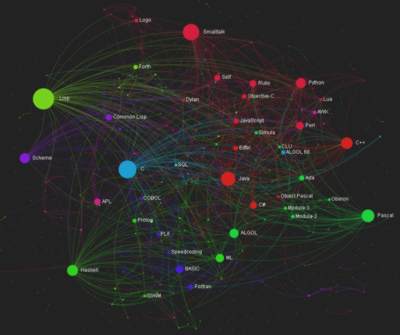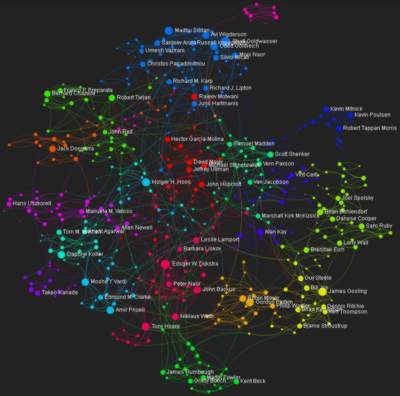| Which Languages Have Most Influence? |
| Written by Kay Ewbank | |||
| Monday, 15 July 2013 | |||
|
How do you rank the relative importance of programming languages? Most developers say it’s obvious; ‘their’ language is the best AND the most important. If you want a more scientific (or should that be artistic) view, check out an interactive network graph that charts languages' relationships. Warning – this graph, which has been created by Ramio Gómez, will waste your entire day, and irritate all the people sharing your office as you loudly ask just HOW LISP could be more influential than SQL (to take a completely random example, but really, HOW?)
Click on the graphic to open the interactive version where you can explore further by clicking on any of the nodes, both those with labels and the minor, unlabeled ones.
The data for the graph has been taken from the table of programming languages maintained on Freebase, a massive collection of data with more than 39 million topics, 2,011 types, and more than 30,000 properties. Gómez has used the language data to create an interactive network graph of programming language influences. The graph consists of 1184 programming language nodes and 972 edges that signify an influence relation. Each node represents a language, and the more influential a language is across all languages in the network, the bigger is the corresponding node in the network. The graph has been rendered with the JavaScript library sigma.js, with a Force Atlas 2 layout that was pre-processed using the Gephi visualization platform. The Python code to retrieve the data from Freebase and generate json and gexf files is provided in a Programming languages Influence repository on GitHub. Gomez has also created a fascinating graph showing how famous programmers are connected based on searches performed on Google. This uses Google’s knowledge graph, where if your Google search is for a person with knowledge graph information you can also see a “People also search for” box with related searches. Gómez entered the names of the creators of the top programming languages according to GitHub to act as seed values: Brendan Eich (JavaScript), Yukihiro Matsumoto (Ruby), James Gosling (Java), Guido van Rossum (Python), Stephen R. Bourne (Bourne shell), William Nelson Joy (C shell), Rasmus Lerdorf (PHP), Dennis Ritchie (C), Bjarne Stroustrup (C++), Larry Wall (Perl), and Brad Cox (Objective-C). If a search result included knowledge graph information indicating the person is a programmer (or hacker or computer scientist) it was included as a node.
(Click to open interactive version) As well as being an informative visualization this is almost a work of art and is available in poster form from Zazzle.
More InformationProgramming languages network graph GitHub Programming languages Influence Other Exploring Data visualizations Related ArticlesProgramming Languages - An Infographic A Brief History Of Programming Languages
To be informed about new articles on I Programmer, install the I Programmer Toolbar, subscribe to the RSS feed, follow us on, Twitter, Facebook, Google+ or Linkedin, or sign up for our weekly newsletter.
|
|||
| Last Updated ( Monday, 15 July 2013 ) |



